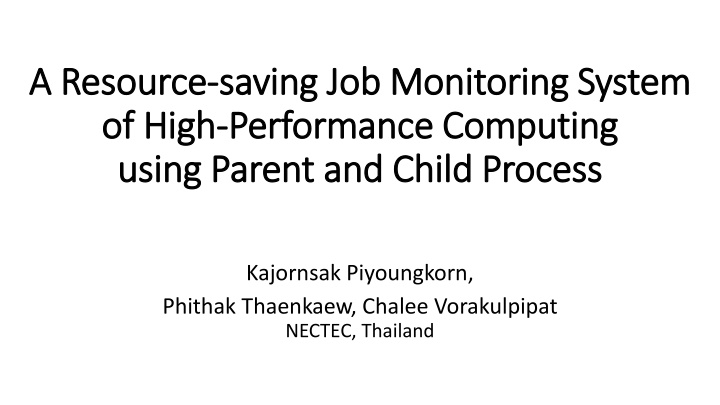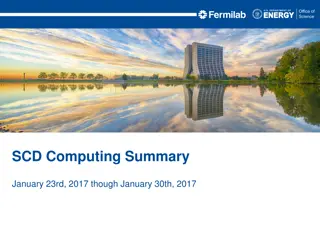Resource-Saving Job Monitoring System for High-Performance Computing
High Performance Computing (HPC) utilizes supercomputers for large computational tasks. The National e-Science Infrastructure Consortium in Thailand provides HPC services to researchers. By optimizing resource utilization and addressing ineffective job execution, the system aims to enhance efficiency and productivity in scientific research, reducing wait times, prolonging hardware life expectancy, and lowering operational costs.
Download Presentation

Please find below an Image/Link to download the presentation.
The content on the website is provided AS IS for your information and personal use only. It may not be sold, licensed, or shared on other websites without obtaining consent from the author.If you encounter any issues during the download, it is possible that the publisher has removed the file from their server.
You are allowed to download the files provided on this website for personal or commercial use, subject to the condition that they are used lawfully. All files are the property of their respective owners.
The content on the website is provided AS IS for your information and personal use only. It may not be sold, licensed, or shared on other websites without obtaining consent from the author.
E N D
Presentation Transcript
A Resource A Resource- -saving Job Monitoring System saving Job Monitoring System of of High High- -Performance Computing Performance Computing using Parent and Child Process using Parent and Child Process Kajornsak Piyoungkorn, Phithak Thaenkaew, Chalee Vorakulpipat NECTEC, Thailand
Introduction Introduction High Performance Computing or (HPC), is the application of "supercomputers" to computational problems that are either too large for standard computers. HPC technology focuses on developing parallel processing algorithms and systems by incorporating both administration and parallel computational techniques. A HPC system is essentially a network of nodes, each of which contains one or more processing chips, as well as its own memory. In Thailand, the National e-Science Infrastructure Consortium was established to create an HPC infrastructure to support Thai scientists to increase their potential and achievements in research.
HPC @NECTEC HPC @NECTEC e e- -Science in Thailand Science in Thailand The National e-Science Infrastructure Consortium is a non-profit organization operated by the government, that provides free HPC service to Academia and Research Institutions in Thailand. The users of the National e-Science Infrastructure Consortium are experts from a variety of fields such as High Particle Physics, Chemistry, Biology, Nanotechnology, Pharmacy, and many more. Each day, the HPC resources have to execute many jobs to produce productivity in scientific research. Normal job requests have to specify requirements such as number of CPU Core processors per compute node, number of compute nodes, Type of Queue (running length)
HPC @NECTEC e HPC @NECTEC e- -Science in Thailand Science in Thailand A solution in this study is to maximize efficiency when using the resources of the computer which involves the processing power of the processor(CPU-Core) For example, a user requests computing resources that does not match the actual usage. Resource requests are calculated in high numbers for maximum processing speed that does not correspond to actual usage, resulting in resource wasting. Thus, a negative effect will go to the hardware system and it will be a hindrance to other users who have to lose an opportunity to use it.
Problem of ineffective job Problem of ineffective job The users have to wait longer for their job to execute. The administrator needs to check the HPC resources repeatedly. The machine getsworn out faster than its life expectancy. The hardware needs to run for long hours continuously to complete executing the job. The hardware overheating problem, cooling facilities, the electricity bill charges also increase.
Job Management System Job Management System The Job Scheduler is responsible for managing jobs that are submitted to the HPC by users. The Job Scheduler usually provides four main functions, such as Job Submission, Schedules, Control, and Monitor HPC resources are managed by a Job Management System(JMS) The JMS works to manage the CPU resources of the HPC according to the jobs requested in the PBS script
HPC architecture on HPC architecture on JMS ( JMS (P Previous study) revious study)
Example PBS script Example PBS script from users to request resources from users to request resources The actual engagement of the HPC resources compute nodes of four processors per node for 18 hours. Hence, the HPC resources are lost for six hours without productivity. As a consequence, the queues waiting for their job execution increase continually, while the booked HPC resources are idle involves two #### PBS Part #### #PBS -N example #PBS -l nodes=4:ppn=8 #PBS -q short (running length) #### End Part ####
HPC (Cluster test) Specification HPC (Cluster test) Specification Frontend node (JMS system) : CPU 2 cores Compute nodes : CPU 16 cores x 5 nodes = 80 cores OS : Linux CentOS 7 Cluster Management : Beowulf Cluster Job Management : PBS/Torque Scheduler Scientific applications : Gaussion 09, Quantum Espresso 5, Gromac 5
HPC job execution via Job Monitoring System HPC job execution via Job Monitoring System
Pseudo code Pseudo code of check job inefficiency of check job inefficiency 1: Get value JobID runtime over 5 Mins. as string 2: Calculate Resource Usage from JobID detail (SessionID) 3: Determine PBS script from JobID (CPU, Memory) 4: While not end of last JobID do 5: Compare Resource Usage and PBS Script Request; 6: if CPU cores & Threads = PBS Script Request then 7: go back to the beginning of current section; 8: else 9: Send notifications through email or terminate process 10:end while 11: finish
Parent and Child process method Parent and Child process method
The accuracy test of the The accuracy test of the JMS between JMS between Utilization Utilization and process and process Utilization method Process method Summary Software Application Accuracy / No. of jobs Accuracy / No. of jobs Accuracy / No. of jobs 10/10 18/20 Gaussian 09 8/10 7/10 9/10 16/20 Quantum Espresso 5.4.0 6/10 8/10 14/20 Gromac 5.0.4 21/30(68%) 27/30(95%) 48/60 (80%) Total
The results before The results before and after use and after use of JMS of JMS % CPU Load % CPU Load Compute Nodes CPU Cores (Max/Use) Compute Nodes CPU Cores (Max/Use) Result Result Inefficiency Good efficiency Good efficiency Inefficiency 16/16 8.00 16/16 cp-00 cp-00 16.00 Inefficiency 16/16 14.00 16/16 cp-01 cp-01 16.00 Inefficiency 16/16 18.00 16/16 4.00 cp-02 cp-02 Inefficiency Inefficiency 16/16 12.00 16/16 14.00 cp-03 cp-03 Good efficiency Resource Usage 68% Good efficiency Resource Usage 95% 16/16 16.00 16/16 16.00 cp-04 cp-04 80/80 80/54 80/80 80/76 Total Total (Utilization method Utilization method: Schedule for 10 Jobs) (Process method Process method: Schedule for 10 Job)
Relation of a Relation of a %CPU Load and Temperature CPU Load and Temperature CPU Cores Usage CPU Temperature ( C) % CPU Load Note 8.00 40 - 50 8/16 Normal 16.00 50 - 60 16/16 Full Load 32.00 60 - 70 16/16 Overload
The comparison of temperature between before and The comparison of temperature between before and after use of JMS in one week after use of JMS in one week Monitoring CPU Temperature in one week (Between 25-31 Mar 19) 80 Temperature ( C) 60 40 20 0 Mon Tue Wen Thu Day Fri Sat Sun Before use of JMS After use of JMS
Conclusions Conclusions The resource-saving JMS is one method that can improve the performance of HPCs in conditions with a heavy load of job requests The method aims to attenuate the work of the system administrator and encourage users to check their job status and HPC resources to increase system efficiency and productivity It is expected to promote ecosystem HPC among the HPC consortium in Thailand
Thank you Thank you























